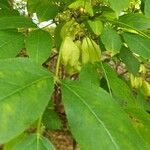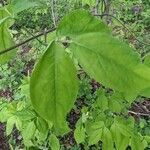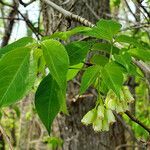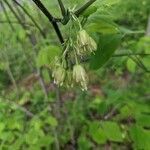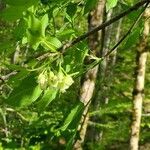Erect shrub to 5 m, with striped bark; lvs long-petioled, 3-foliolate, the lfls oblong to elliptic or ovate, 5–10 cm, serrate, the terminal one long-stalked, the lateral sessile or short-stalked and often oblique at base; infls 4–10 cm (peduncle included); fls long-pedicellate, greenish-white, campanulate, 8–10 mm; fr 3-lobed, 5 cm; 2n=78. Moist woods and thickets; s. Que. to Minn., s. to Ga., w. Fla., and Okla. May.
A shrub. The leaves have 3 leaflets and these are 5-8 cm long. The leaflets have fine points and sharp teeth. There are fine hairs underneath the leaves. The leaves change colour in autumn. The flowers are white and 35 mm long. They are in short panicles. The fruit has 3 lobes.
